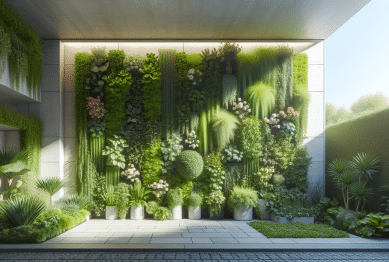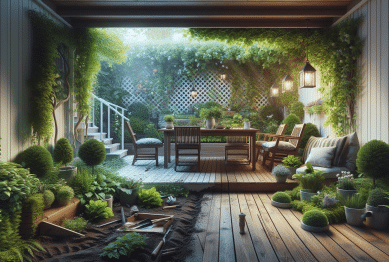Discover how vertical gardens offer a lush, space-saving solution for any home or apartment. This guide explores easy planting methods, eco-friendly benefits, and creative tips for beginners and pros alike, helping you make the most of every inch indoors or out while supporting plant health and home aesthetics.
Understanding Vertical Gardens for Limited Spaces
Vertical gardens, also known as living walls, are a stylish and practical option for those limited by space. They allow anyone to bring nature indoors or embellish urban balconies without occupying precious square footage. This approach utilizes vertical surfaces, transforming blank walls into lush, vibrant backdrops filled with herbs, flowers, or even small vegetables. For people with minimal outdoor areas, vertical planters can become a source of fresh produce or natural beauty right at home.
Many city dwellers or apartment renters find themselves wishing for the benefits of a home garden but feel restricted by spatial constraints. Vertical gardening bypasses these barriers by moving plant life upward, making use of walls, fences, or special frames. Installing shelves, pockets, or modular panels can turn a once-empty corner into a thriving green ecosystem. The possibilities range from a simple DIY project with recycled materials to advanced systems with integrated irrigation.
Homeowners and renters alike appreciate vertical gardens for their adaptability and ease of customization. From succulents and cascading ferns to edible greens, the plant selection can be tailored to meet both light conditions and personal tastes. Properly maintained, these living walls do more than add beauty—they purify the air, regulate humidity, and bring a touch of tranquility to indoor environments. Learning how to maximize a vertical setup is often the key to unlocking gardening potential where space is at a premium.
Choosing the Right Plants for Your Vertical Garden
Selecting plants that thrive in vertical conditions is crucial for ongoing success. Consider light exposure, temperature, and water needs when deciding what to grow. Leafy greens like lettuce or kale, along with herbs such as basil or mint, often adapt well to smaller soil volumes and vertical planters. These choices also lend themselves beautifully to a kitchen wall garden, offering edible rewards for your care and attention.
The aesthetics of a vertical garden can be personalized by mixing textures and colors. Trailing plants like pothos or string of pearls add dynamic movement, while ferns and mosses create a soft, carpeted effect. Flowering plants such as begonias or impatiens can add pops of color to brighten both interiors and exteriors. Researching the specific needs of your favorite species helps prevent common issues like overwatering or root crowding within compact vertical systems.
Native and drought-resistant plants are excellent picks for low-maintenance vertical gardens, especially in sunny outdoor installations. Using local flora supports pollinators and often requires less upkeep. For shaded spaces, try heartleaf philodendron or English ivy, which can flourish with less direct sun. Successful vertical gardening often combines creativity with basic plant science, leading to beautiful yet easy-to-manage results for all experience levels.
Step-by-Step Guide to Setting Up a Vertical Garden
Starting a vertical garden begins with choosing the right structure. Options include premade systems, trellises, wall panels, or even repurposed items like wooden pallets. Good drainage is essential to prevent water from accumulating and harming plant roots. When installing indoors, use waterproof backing and drip trays to protect walls and floors. Outdoors, select spots that balance sunlight with weather protection to help sensitive plants thrive.
Next, assemble your vertical garden by positioning pockets, containers, or shelves securely to support the weight of both soil and mature plants. Fill with a lightweight, well-draining potting mix. If possible, install an irrigation system—drip lines or self-watering reservoirs can simplify upkeep and ensure consistent moisture. Before placing plants, arrange them in their containers to visualize overall design and ensure all receive adequate light.
After planting, maintain regular care by monitoring moisture and trimming overgrown stems. Fertilize sparingly to encourage healthy growth without overwhelming the confined root zones. Vertical gardens tend to dry out faster than traditional beds, so check soil regularly and adjust watering routines as seasons change. As plants settle in, observe how the microclimate around your living wall evolves—it may impact humidity and even temperature in adjoining rooms.
Eco-Friendly Advantages of Vertical Gardens
Incorporating green infrastructure like vertical gardens into homes and communities brings environmental benefits. These gardens improve local air quality by absorbing carbon dioxide and volatile compounds while releasing oxygen. In dense urban areas, living walls even help to reduce heat island effects, cooling surrounding spaces and offering habitats for birds and beneficial insects.
Vertical gardening conserves water compared to traditional lawns or ground beds, especially when paired with efficient drip irrigation. Rainwater collection systems can also be integrated, allowing gardeners to recycle water while supporting lush growth above ground. Choosing native plant species further maximizes sustainability, requiring fewer resources and fostering biodiversity within built environments.
Besides environmental gains, vertical gardens bring health benefits to those around them. Studies suggest that proximity to plants can lower stress and improve overall well-being. Living walls may regulate household humidity, creating more comfortable interiors. By embracing these sustainable gardening practices, individuals contribute to both personal wellness and the planet’s resilience.
Creative Ideas for Vertical Garden Design
Inventive materials and layouts keep vertical gardens exciting. Consider using wall-mounted planters arranged in geometric patterns or creating a living mural with colorful succulents. Pocket organizers, shoe racks, or upcycled bottles transform into artistic displays when filled with greenery. For enhanced visual impact, alternate plant sizes and leaf shapes to provide depth and dimension to your design.
Lighting can dramatically influence how vertical gardens feel. Add LED grow lights for indoor installations, highlighting foliage or simulating daylight if natural sources are scarce. Select accent lighting for outdoor features to transform garden walls into evening focal points. The right illumination encourages robust plant health and makes living art visible long after sunset.
Accessorizing living walls with decorative touches—such as small sculptures, water features, or hanging birdhouses—further personalizes the space. Some gardeners include aromatic herbs for sensory appeal or edible blooms for a functional twist. Adapt your vertical garden to suit any taste or mood, knowing that each setup can be refreshed throughout the year with new plant selections.
Maintaining a Healthy and Productive Vertical Garden
Consistent care helps vertical gardens flourish long-term. Routine pruning shapes plant growth, removing dead or overcrowded foliage to allow new shoots space and light. Regular pest inspections prevent infestations from spreading, especially in densely packed arrangements. Simple organic solutions are often enough to keep unwanted visitors in check.
Nutrition matters. Feeding plants with balanced, slow-release fertilizers ensures even those growing in limited soil receive essential nutrients. Monitor plant health for early signs of nutrient deficiencies, such as yellowing leaves or stunted growth. Amend soil or supplement as needed, keeping overall garden vitality at peak performance.
Record-keeping assists in troubleshooting and improvement. Track which species thrive, and note environmental changes or maintenance tweaks that yield better results. With experience, home gardeners can fine-tune watering schedules, mix-and-match plant communities, and achieve lush, low-maintenance living walls that become a rewarding focus in any living space.
References
1. United States Environmental Protection Agency. (2022). Green Infrastructure—Vertical Gardens. Retrieved from https://www.epa.gov/green-infrastructure/green-infrastructure-vertical-gardens
2. The Royal Horticultural Society. (n.d.). Vertical Gardening. Retrieved from https://www.rhs.org.uk/advice/profile?pid=1017
3. University of Florida IFAS Extension. (n.d.). Vertical Gardens for Small Spaces. Retrieved from https://edis.ifas.ufl.edu/publication/EP524
4. American Society of Landscape Architects. (n.d.). Benefits of Green Walls. Retrieved from https://www.asla.org/ContentDetail.aspx?id=43567
5. Green Roofs for Healthy Cities. (n.d.). Vertical Gardens. Retrieved from https://greenroofs.org/vertical-gardens/
6. University of Illinois Extension. (n.d.). Creative Ideas for Vertical Gardens. Retrieved from https://extension.illinois.edu/blogs/flowers-fruits-and-frass/2021-05-28-creative-vertical-gardens









